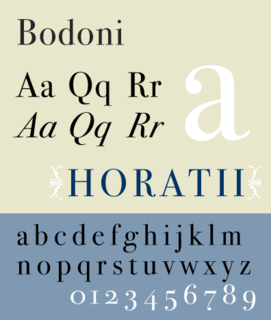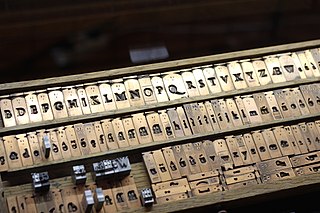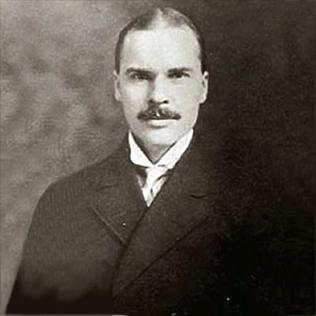
Garamond is a group of many serif typefaces, named for sixteenth-century Parisian engraver Claude Garamond, generally spelled as Garamont in his lifetime. Garamond-style typefaces are popular and particularly often used for book printing and body text.

Bodoni is the name given to the serif typefaces first designed by Giambattista Bodoni (1740–1813) in the late eighteenth century and frequently revived since. Bodoni's typefaces are classified as Didone or modern. Bodoni followed the ideas of John Baskerville, as found in the printing type Baskerville—increased stroke contrast reflecting developing printing technology and a more vertical axis—but he took them to a more extreme conclusion. Bodoni had a long career and his designs changed and varied, ending with a typeface of a slightly condensed underlying structure with flat, unbracketed serifs, extreme contrast between thick and thin strokes, and an overall geometric construction.
In film, television, and theatre, typecasting is the process by which a particular actor becomes strongly identified with a specific character, one or more particular roles, or characters having the same traits or coming from the same social or ethnic groups. There have been instances in which an actor has been so strongly identified with a role as to make it difficult for them to find work playing other characters.

In the manufacture of metal type used in letterpress printing, a matrix is the mould used to cast a letter, known as a sort. Matrices for printing types were made of copper.

Morris Fuller Benton was an American typeface designer who headed the design department of the American Type Founders (ATF), for which he was the chief type designer from 1900 to 1937.

American Type Founders (ATF) was a business trust created in 1892 by the merger of 23 type foundries, representing about 85% of all type manufactured in the United States. The new company, consisting of a consolidation of firms from throughout the United States, was incorporated in New Jersey.

Punchcutting is a craft used in traditional typography to cut letter punches in steel as the first stage of making metal type. Steel punches in the shape of the letter would be used to stamp matrices into copper, which were locked into a mould shape to cast type. Cutting punches and casting type was the first step of traditional typesetting. The cutting of letter punches was a highly skilled craft requiring much patience and practice. Often the designer of the type would not be personally involved in the cutting.

Jim Crow is the American Type Founders' 1933 and 1949 re-casting of the Dickinson Type Foundry's type of the 1850s, Gothic Shade. Dickenson, a Boston type foundry, had been incorporated into ATF in the original merger of 1892. The face was also known as Tombstone. ATF only cast the face in 24 point, but later versions by the Los Angeles Type Foundry were cast from 18 to 30 point. It was often used to indicate political motifs. While cold type versions were popular right through the 1970s, no major foundry has issued a digital version, and it is seldom used today. Foundry Harold's Fonts has released a digitised version named Jim Dandy.

The Type Archive is a collection of artefacts representing the legacy of type founding in England, whose famous type foundries and composing systems supplied the world with type in over 300 languages. The Archive was founded in 1992 by Susan Shaw in Stockwell, South London.

Type casting is a technique for casting the individual letters known as sorts used in hot metal typesetting by pouring molten metal into brass moulds called matrices.

Stephenson Blake is an engineering company based in Sheffield, England. The company was active from the early 19th century as a type founder, remaining until the 1990s as the last active type foundry in Britain, since when it has diversified into specialist engineering.

Linn Boyd Benton was an American typeface designer and inventor of technology for producing metal type.
Robert Wiebking (1870–1927) was a German-American engraver typeface designer who was known for cutting type matrices for Frederic Goudy from 1911 to 1926.

The Intertype Corporation produced the Intertype, a typecasting machine closely resembling the Linotype, and using the same matrices as the Linotype. It was founded in New York in 1911 by Hermann Ridder, of Ridder Publications, as the International Typesetting Machine Company, but purchased by a syndicate for $1,650,000 in 1916 and reorganized as the Intertype Corporation.
Western Type Foundry was founded in 1901 to compete with the conglomerate and near-monopoly, American Type Founders. In 1914 Western purchased the Advance Type Foundry in Chicago from Wiebking, Hardinge & Company, though even before this Robert Wiebking did most of the punch-cutting and matrix making for Western. Among the matrices that Wiebking for the foundry were his own designs for Farley,Perry,Artcraft, and Advertisers Gothic, a re-cutting of Caslon, and the original matrices for Bruce Rogers's deservedly famous Centaur typeface. The foundry was closed in 1919, transferring all of its equipment and holdings to Barnhart Brothers & Spindler in 1919.
Artcraft is an Old Style typeface engraved in 1912 by Robert Wiebking for Wiebking, Hardinge & Company which ran the Advance Type Foundry. It was originally called Craftsman, then Art-Craft, before finally becoming Artcraft. After Advance was sold to the Western Type Foundry in 1914, Wiebking added Artcraft Bold and Artcraft Italic. After Western was sold to Barnhart Brothers & Spindler the face was sold by both BB&S and ATF.
Samuel Winfield "Tommy" Thompson (1906–1967) was an American calligrapher, graphic artist and typeface designer. He was born Blue Point, New York. In 1944 he became the first designer to earn royalties for a type design, from Photo Lettering Inc. for his Thompson Quill Script. Previously, designers had worked in house for foundries or had sold the rights to their faces outright. He maintained a studio in Norwalk, Connecticut and was the author of several books on type and lettering.
Stevens, Shanks & Sons Ltd. was an English type foundry formed in 1933 by the merger of the Figgins Foundry with P. M. Shanks to form Stevens, Shanks. Sometime after 1971 the foundry ceased operations and all materials went to St. Bride's Printing Library.
The Inland Type Foundry was an American type foundry established in 1894 in Saint Louis, Missouri and later with branch offices in Chicago and New York City. Although it was founded to compete directly with the "type trust", and was consistently profitable, it was eventually sold to ATF.











